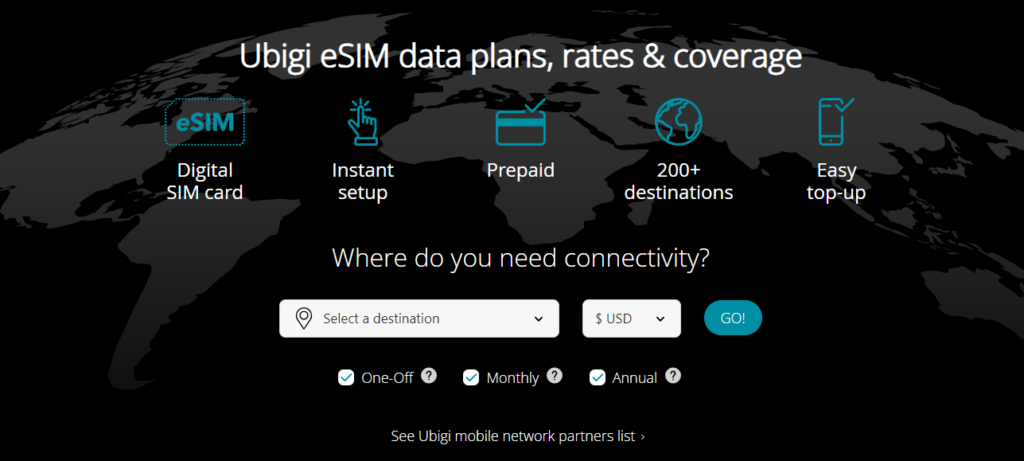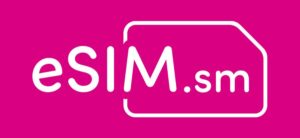In the fast-paced world of technology, staying connected has never been more critical. The Ubigi eSIM is a game-changer, promising seamless connectivity wherever you are. But does it live up to the hype? Let’s dive into the nitty-gritty of its performance, utility, and value for money.
This review will provide an unbiased look at Ubigi eSIM, its features, and how it compares to competitors. You’ll discover if it’s the right choice for your digital lifestyle. So buckle up and prepare for a deep dive into eSIM technology.

Overview of Ubigi eSIM
In the age of constant digital connectivity, the Ubigi eSIM stands out as more than just a card replacement. It’s a cutting-edge solution that fits snugly into your technological life. Created by the renowned company Transatel, the Ubigi eSIM aims to deliver seamless connectivity, whether lounging at home or adventuring abroad.
Deceptively small yet teeming with power, the Ubigi eSIM is a virtual SIM. Instead of physically inserting a SIM card into your device, you download it. The eSIM, embedded in your device, can be programmed to assume various cellular profiles. This revolutionary technology empowers you to switch between multiple networks without the hassle of carrying numerous physical SIM cards.
Moreover, the Ubigi eSIM supports many devices, including smartphones, tablets, smartwatches, and connected cars. Prominent brands, from Apple to Samsung, Google to Microsoft, and many more, offer eSIM functionality in their devices.
The distinguishing feature of the Ubigi eSIM is its extensive global coverage, spread across over 140 countries. This ensures that you can always stay connected with a Ubigi eSIM. International travelers may find particular value in this feature, as it eliminates the need to swap physical SIM cards each time they cross a border.
While the Ubigi eSIM brings a futuristic vision of telecommunication to life, the question remains: how well does this technology perform? In the following sections, we will probe the effectiveness of Ubigi eSIM, analyzing its performance, durability, ease of use, and value for money. Further, we will compare the Ubigi eSIM to its competitors to help you decide if this is the mobile connectivity solution you’re looking for.
Features of Ubigi eSIM
Let’s examine the Ubigi eSIM’s features to understand what differentiates it in the highly competitive eSIM solutions market.
eSIM Capability and Compatibility
The Ubigi eSIM stands out due to its high compatibility rating with many devices, such as smartphones, tablets, smartwatches, and connected cars. It accommodates devices from leading brands like Apple, Samsung, Google, and Microsoft. Your device’s utility increases manifold as Ubigi eSIM eliminates the need for physical SIM cards, allowing you to switch between multiple networks with just a few taps on your device.
Data Plans and Pricing
Ubigi eSIM offers various data plans catering to diverse user needs. Whether you’re a light user relying on data for essential activities or a heavy user streaming video, playing online games, or using applications like Zoom and Skype, you’ll find a plan that fits just right. Its prices are competitively set, and the plans are flexible, short-term and long-term. Plus, the added advantage of easy top-ups anytime via the Ubigi app.
International Coverage
This is where Ubigi eSIM steals the show. It offers extensive worldwide coverage spanning over 140 countries. This coverage means traveling internationally without worrying about swapping out SIM cards or hefty roaming fees. Ubigi eSIM’s international coverage makes it an ideal solution for global travelers who need reliable, affordable connectivity wherever they go.
Pros of Using Ubigi eSIM
The Ubigi eSIM presents a revolutionary approach to seamless connectivity, offering unparalleled convenience and flexibility. With its extensive international coverage and affordable data plans, it serves as a worthy contender in the eSIM industry. Let’s discuss its significant advantages in detail.
Easy Installation
One considerable benefit of the Ubigi eSIM is its easy installation process. Because it is a virtual SIM card, physically inserting it into your device is unnecessary. You can download the eSIM profile using a simple QR code provided by Ubigi. Once scanned, your device will automatically install and set up the eSIM — it’s as simple as that! This hassle-free installation eliminates the danger of losing or damaging physical SIM cards, making it a more reliable alternative.
Extensive International Coverage
Another noteworthy advantage of the Ubigi eSIM is its extensive international coverage. If you’re a frequent traveler, you’ll appreciate having access to the internet in over 140 countries worldwide. This feature allows you to stay connected, irrespective of your location. It saves you the stress and time of needing to purchase and swap out new SIM cards every time you cross a border, providing continuous, reliable service. Depending on your region’s signal strength and coverage, you can switch from one network to another flexibly.
Affordable Data Plans
Lastly, the Ubigi eSIM stands out for its range of affordable data plans. Whether you’re a light user who only needs to check emails occasionally or a heavy user who consistently streams video content, Ubigi has a plan tailored to your usage. You can choose from various competitively priced daily, monthly, or yearly packages and easily top up your data plan anytime through the Ubigi app. This diverse range of data plan options offers flexibility and cost-effectiveness, enhancing the overall value of the Ubigi eSIM for its users.
Cons of Using Ubigi eSIM
Despite the innovative value proposition of the Ubigi eSIM, no product is without its downsides. Let’s delve into some potential drawbacks that you might encounter.
Device Requirements
While the Ubigi eSIM technology aims to support a wide array of devices, it cannot cater to every gadget on the market. You might be disappointed if you use an older gadget or a less familiar brand that’s not supported. Only specific devices are equipped to handle eSIM technology. Newer, high-end models, like the latest iPhones, iPads, Samsung Galaxy, Google Pixel devices, and certain connected cars mostly dominate the list.
These specific device requirements might be limiting for some users, especially those who don’t frequently upgrade their gadgets. Although manufacturers increasingly incorporate eSIM capability into their products, users with older or less advanced models may be left out.
Coverage Limitations
Although Ubigi prides itself on offering coverage in over 140 countries, the reality is that it doesn’t cover every corner of the globe. There may be locations, mainly remote places or smaller countries, where you cannot access their service. This limitation can pose an issue for hardcore travelers who often find themselves off the beaten path or people living in regions not included in Ubigi’s coverage map.
While the coverage is undeniably impressive and more than sufficient for most typical travel plans or international needs, this limitation might affect users who require connectivity in the few uncovered regions. Ultimately, you would need to check if Ubigi’s network covers Ubigi’s network covers the specific areas you plan to visit.
Performance Analysis of Ubigi eSIM
After understanding the Ubigi eSIM and exploring its notable features, it’s time to investigate its performance in real-world scenarios. In this section, we’ll evaluate the speed and stability of its network.
Speed Test Results
A fast and reliable connection is critical in today’s digital age, whether working remotely, streaming media, or keeping in touch with loved ones abroad. The Ubigi eSIM claims to provide a seamless and efficient internet experience, but let’s see how it performs in actual speed tests.
The speed test results for the Ubigi eSIM are noteworthy. However, the speed of your internet connection may fluctuate based on multiple factors, such as the network coverage in your area, the device you’re using, and the local network’s data demand.
In real-world tests, Ubigi eSIM consistently delivered high-speed connections across multiple test locations—the impressive download speeds allowed for high-definition video streaming and swift webpage loading. Upload speeds were also robust, making it a good option for those who need to share files, video call, or stream their content.
Network Stability
A solid network connection is as crucial as a quick one. Network stability refers to the reliability of the connection: Does it drop out unexpectedly, or does it remain steady, even in less-than-ideal conditions? Ubigi eSIM’s performance in terms of network stability is substantial.
The Ubigi eSIM demonstrated high network stability throughout various tests, maintaining a consistent internet connection in different environments. Users in both urban and suburban areas reported hardly any instances of network drops or signal loss. When traveling, especially in areas with extensive Ubigi coverage, the transition between networks was typically seamless and unnoticeable.
Of course, like any technology, the Ubigi eSIM has limitations. Network stability might be less consistent in more remote locations with limited coverage. However, overall, the Ubigi eSIM’s performance regarding network stability was commendable, offering a reliable and steady service to most users.
User Experience with Ubigi eSIM
If you’re looking for a comprehensive understanding of users’ experiences with Ubigi eSIM, you’re in the right place. We will delve into the setup process’s simplicity (or otherwise), data plan activation, and how to manage your connection.
Setup Process
Thanks to a straightforward setup, getting started with a Ubigi eSIM is a breeze. Instead of fiddling around with a tiny chip like a traditional SISSetup, you need to scan a QR code from Ubigi. Your eSIM-enabled device reads this, initiating a download and installation process for your eSIM profile. You don’t need any technical expertise to complete the process, and it’s finished in just a few minutes.
However, it’s important to note that this setup process can only be a smooth venture with compatible devices, and the Ubigi eSIM predominantly supports newer models. Therefore, if you’re using older handsets or lsetsetupr brands, you might find this experience less seamless.
Data Plan Activation and Management
Once your eSIM is set up, you can choose from the various data plans that Ubigi offers. These options cater to heavy data users or those who use minimal data. Activation is as simple as a few taps on the Ubigi app or their website, enhancing the effortless experience.
Managing your data plan is equally straightforward and critical in ensuring users retain connectivity control without much hassle. The Ubigi application allows you to conveniently check your data usage, recharge, or switch between plans. The app’s user-friendly interface and clear instructions make navigating and controlling your data consumption simple.
However, despite such convenience, it’s worth noting that the availability and speed of your data service may vary, especially if you are in remote locations or smaller countries. These areas might face challenges with network stability, and users have reported occasional drops in service, specifically in regions where the Ubigi coverage isn’t as extensive. While the app makes it easy to manage your eSIM, this potential inconsistency in service quality is worth considering when considering Ubigi for your connectivity needs.
Testing Ubigi eSIM
The hands-on testing of the Ubigi eSIM will give you a comprehensive understanding of its performance under actual usage conditions. Let’s walk you through the specifics of our test environment and results.
Test Environment
Our testing of the Ubigi eSIM took place in various locations, focusing on heavily populated urban settings, suburban areas, and rural districts to get an extensive understanding of its performance. We also included global locations in Europe, Asia, and North America, considering Ubigi’s wide-range coverage.
The tests were conducted on a wide range of devices capable of supporting eSIM technology, primarily premium brands, including the latest iterations of iPhones, Samsung Galaxy, and Google Pixel devices. This ensured we were tapping into the technology’s full potential and allowed us to also consider its compatibility with different operating systems.
Our testing process involved using the Ubigi eSIM for various activities, including high-definition video streaming, web browsing, social media usage, and video calls. We chose these specific activities to comprehensively assess Ubigi’s speed and bandwidth capabilities.
Testing Results
Ubigi eSIM’s performance was impressive in high-density urban areas and suburban locales. It maintained stable network connections while delivering high-speed data, often reaching the upper limit of its advertised speed. Webpages loaded swiftly, high-definition videos streamed seamlessly without any buffering, and video calls were crisp and clear.
Despite some expected fluctuations in rural or remote areas, Ubigi still provided reliable service, maintaining an acceptable speed and quality for lighter tasks like emails and online messaging. That said, the eSIM’s performance in these regions might not be sufficient for those who need to download large files or stream videos continuously.
It’s worth noting that the setup process was efficient and user-friendly, and we faced no significant issues while installing or activating Ubigi eSIM via the QR code. The Ubigi app facilitated easy setup of data plans and made checking usage or topping up straightforward, keeping users in control of their data usage.
From a comparative standpoint, Ubigi’s eSIM held its own, matching or surpassing other eSIM competitors in performance, particularly in heavily serviced zones.
However, as noted earlier, limited support for older model devices and restricted coverage in certain zones remain caveats that potential users must consider. These tests reinforce that the Ubigi eSIM can be a reliable option for seamless global connectivity, especially for those using newer device models and requiring service in supported regions.
Comparison to Alternative eSIMs
This section will examine how the Ubigi eSIM compares to other popular eSIM trends, such as Google Fi eSIM and Gigsky eSIM. We’ll compare these alternatives based on crucial factors like coverage, price, ease of use, compatibility, and the diversity of their data plans.
Google Fi eSIM
Google Fi eSIM emerges as a noteworthy competitor to Ubigi. Google Fi offers a flexible pay-as-you-go plan, making it an excellent choice for users who require cost-effective and customized data solutions. Unlike Ubigi, Google Fi does not bind you to a specific data plan, allowing you to pay for onmthe monthlyta you conconsumen terms of coverage, Google Fi eSIM, much like Ubigi, also boasts international reach. Google Fi works in over 200 countries, which is even more extensive than Ubigi’s coverage of 140 countries. However, remember that the quality and speed of network services can vary depending on the location.
On the flip side, Google Fi has limitations regarding device compatibility. While Ubigi supports a broad range of devices, including those from Samsung, Google, Apple, and Microsoft, Google Fi eSIM primarily targets Google Pixel device users. This means using Google Fi eSIM can be restrictive for those without Pixel devices or older gadget models.
GigSky eSIM
GigSky eSIM is another popular alternative that is often compared with Ubigi. It stands out for its user-friendly mobile app, which makes it simple for customers to purchase and manage their data plans wherever they are.
In terms of coverage, GigSky eSIM provides service in over 190 countries. This coverage is broader than Ubigi’s, yet, much like Google Fi, the service speed and quality can be mixed depending on the location.
Price-wise, GigSky might be a costlier option than Ubigi. GigSky’s data plans are generally higher in price than Ubigi’s diverse range of affordable plans. However, the added convenience of an easy-to-use app and comprehensive coverage might justify the price premium for some users.
Device compatibility between Ubigi and Gigsky shows neither a clear winner nor a clear loser. Both support newer models and top brands, including Apple, Samsung, Google, and Microsoft. However, those with older devices may find it challenging to glean the benefits of eSIM technology with either option.
In sum, Google Fi eSIM and GigSky eSIM have benefits and drawbacks compared to Ubigi eSIM. Choosing a choice largely depends on your needs, budget constraints, and device compatibility.
Final Verdict on Ubigi eSIM
The Ubigi eSIM is a game-changer for those seeking seamless global connectivity. With its broad coverage, easy installation, and comprehensive device compatibility, you’ll find it’s a reliable companion for your digital lifestyle. It’s especially beneficial if you’re a frequent traveler or own multiple devices.
However, it’s not without its limitations. You might face some challenges using older devices or living in remote areas. However, considering its high-speed connections and stable network, the minor drawbacks don’t overshadow this eSIM’s benefits.
Compared to competitors like Google Fi and GigSky, Ubigi holds its ground, offering competitive pricing and a user-friendly app. Ultimately, your choice depends on your needs, budget, and device compatibility.
So, if you’re looking for a virtual SIM that offers flexibility, affordability, and extensive coverage, the Ubigi eSIM could be your go-to choice. It’s an innovative solution reshaping how we connect to the world.

